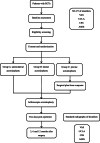Effect of arthroscopic acromioplasty on reducing critical shoulder angle: a protocol for a prospective randomized clinical trial
- PMID: 33287773
- PMCID: PMC7722311
- DOI: 10.1186/s12891-020-03818-w
Effect of arthroscopic acromioplasty on reducing critical shoulder angle: a protocol for a prospective randomized clinical trial
Abstract
Background: The critical shoulder angle (CSA), which helps to predict patients who are at risk of rotator cuff tears (RCTs) with large degree and who are susceptible to osteoarthritis with low angle, has been identified as one of the most vital acromial parameters; anterolateral and lateral acromioplasties have been proven to be valid ways to reduce CSA. However, no study has compared the effect of different acromioplasties on the reduction of the large CSA (≥33°) clinically. Additionally, either anterolateral or lateral acromioplasty could not precisely correct large CSAs to a favorable range (30-33°) in each patient. Thus, we will propose a novel precise acromioplasty technique for the purpose of reducing CSA accurately and effectively, and compare the effectiveness of different acromioplasties on the reduction of the CSA.
Methods: A total of 60 RCT patients who have indications for arthroscopic rotator cuff repair and with pre-operative CSA ≥33° will be recruited in outpatient center of Sun Yat-sen Memorial Hospital. Eligible participants will be randomly allocated to Group A (anterolateral acromioplasty), Group B (lateral acromioplasty) or Group C (precise acromioplasty) via a random, computer-generated number system. Three surgical plans will be made for each participant respectively by one professional surgeon according to the results of randomization allocation. The post-operative CSA will be measured 2 days post-operation. Follow-up will be maintained at 3, 6, and 12 months after surgery including the visual analog scale score, the University of California at Los Angeles score, the Constant Shoulder Score and the American Shoulder and Elbow Surgeon Shoulder Assessment Form. Finally, all outcomes will be assessed by two researchers who are blinded to the recruitment and allocation.
Discussion: This is the first clinical trial to evaluate the impact of different acromioplasties on the reduction of the CSA. Additionally, this study will provide a new precise acromioplasty technique, which is a novel precision and individualized treatment to prevent degenerative RCTs by reducing the CSA.
Trial registration: ChiCTR2000032343 . Registered on April 26th, 2020.
Keywords: 3D reconstruction; Acromioplasty; Critical shoulder angle; Rotator cuff tears.
Conflict of interest statement
The authors declare no competing interests.
Figures



Similar articles
-
Does the critical shoulder angle decrease after acromioplasty? A systematic review and meta-analysis.J Orthop Surg Res. 2022 Jan 15;17(1):28. doi: 10.1186/s13018-022-02927-7. J Orthop Surg Res. 2022. PMID: 35033137 Free PMC article.
-
Arthroscopic Correction of the Critical Shoulder Angle Through Lateral Acromioplasty: A Safe Adjunct to Rotator Cuff Repair.Arthroscopy. 2018 Mar;34(3):771-780. doi: 10.1016/j.arthro.2017.08.255. Arthroscopy. 2018. PMID: 29100767
-
Lateral acromioplasty cannot sufficiently reduce the critical shoulder angle if preoperatively measured over 40°.Knee Surg Sports Traumatol Arthrosc. 2021 Jan;29(1):240-249. doi: 10.1007/s00167-020-05951-4. Epub 2020 Apr 4. Knee Surg Sports Traumatol Arthrosc. 2021. PMID: 32248274
-
[Clinical effect of modified anterolateral acromioplasty in rotator cuff repair under shoulder arthroscope].Zhonghua Yi Xue Za Zhi. 2024 Aug 27;104(33):3142-3147. doi: 10.3760/cma.j.cn112137-20240126-00206. Zhonghua Yi Xue Za Zhi. 2024. PMID: 39168845 Chinese.
-
Efficacy of concomitant acromioplasty in the treatment of rotator cuff tears: A systematic review and meta-analysis.PLoS One. 2018 Nov 15;13(11):e0207306. doi: 10.1371/journal.pone.0207306. eCollection 2018. PLoS One. 2018. PMID: 30439995 Free PMC article.
Cited by
-
Effect of Arthroscopic Acromioplasty Combined with Rotator Cuff Repair in the Treatment of Aged Patients with Full-Thickness Rotator Cuff Tear and Rotator Cuff Injury.Emerg Med Int. 2022 Aug 3;2022:4475087. doi: 10.1155/2022/4475087. eCollection 2022. Emerg Med Int. 2022. Retraction in: Emerg Med Int. 2024 Jan 24;2024:9808439. doi: 10.1155/2024/9808439. PMID: 35966500 Free PMC article. Retracted.
-
Predictability and functional impact of lateral acromioplasty using preoperative 2D planning on the correction of the critical shoulder angle (CSA) in patients with rotator cuff repair.JSES Int. 2024 May 28;8(5):1023-1028. doi: 10.1016/j.jseint.2024.05.009. eCollection 2024 Sep. JSES Int. 2024. PMID: 39280157 Free PMC article.
-
The Critical Shoulder Angle Can be Accurately and Reliably Determined from Three-Dimensional Computed Tomography Images.Orthop Surg. 2023 Aug;15(8):2052-2061. doi: 10.1111/os.13652. Epub 2023 Jan 20. Orthop Surg. 2023. PMID: 36660945 Free PMC article.
-
Impact of critical shoulder angle in shoulder pathology: a current concepts review.JSES Int. 2023 Nov 29;8(2):287-292. doi: 10.1016/j.jseint.2023.11.002. eCollection 2024 Mar. JSES Int. 2023. PMID: 38464445 Free PMC article. Review.
-
Does the critical shoulder angle decrease after acromioplasty? A systematic review and meta-analysis.J Orthop Surg Res. 2022 Jan 15;17(1):28. doi: 10.1186/s13018-022-02927-7. J Orthop Surg Res. 2022. PMID: 35033137 Free PMC article.
References
Publication types
MeSH terms
Grants and funding
LinkOut - more resources
Full Text Sources
Medical
Miscellaneous

